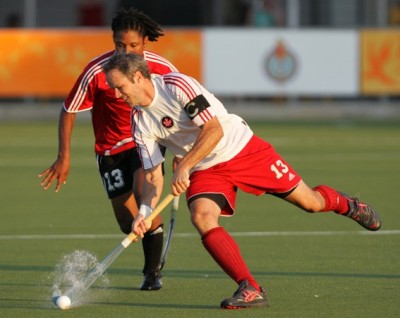
Chronological Age: 19 +/- yrs and beyond
Training to Win is the final stage of preparation. Athletes now have a full complement of skills and abilities to achieve success. All facets of training have been developed and are now exercised to maximum capacity. Responsibility now falls on an athlete not only for their own individual performance but that of the team as well. Consistent mastery and execution in all areas of performance must occur.
The athlete’s physical, technical, tactical, mental, and ancillary capacities should now be firmly established. The focus of training is on refining all skills and abilities and continuing to zero in on the optimization of performance to peak for major competitions. World-class athletes require world-class training methods, equipment, and facilities that meet the demands of international field hockey.
The competition ratio shifts to 20:80 with the competition percentage including competition-specific training activities. Domestic competition occurs once or twice per week over a multiple month season with built in rest periods while international competition sees multiple games over the week during intense periods followed by rest. The athlete should have total dedication to field hockey with sessions 9-15 times per week incorporating all facets of physical and mental training.
Physical
All systems are fully trainable. Testing determines the priorities of training emphasis such as individual fitness for maintenance and improvement, high level of work rate encouraged along with institution of proper lengths of recovery, commitment to rigorous training, and performance (result) oriented goals.
Technical
Game-related technical repetition under pressure in important for this stage. Players are normally identified for provincial, junior, or senior squad.
This stage is focused on perfection of skills although elements of advanced skills may still be developed such as uses of skills for specific positions or tactical reasons (when, where and how).
Hit, sweep or push pass with reference to distance and pressure.
Specific positional and set play specialization is established and mastered.
Tactical
Athletes have a high degree of decision-making, leadership, and game analysis. They possess advanced use of skills for tactical play such as cross-field scoops to break from a press and also set the stage for a quick attack.
Counter attack by use of good position for absorbing the attack and then launching an attack. Switch off marking and covering, communication with players for changes in tactics and ability to adjust game plan, adapt strategies to suit changing demands. They also understand the correct method of entry into the circle (eg. direct or baseline).
Mental
Competitive attitude and will to win is solidified. Focus on individualized mental strategies used to prepare and perform consistently under a variety of competitive situations. An increased emphasis is on personal responsibility and player involvement in decision-making. Athletes utilize on and off-field strategies to maximize teamwork.
Mental capacities: Individualized mental training program and consistent use and application of mental skills, regular monitoring, evaluating, and adjusting of goals (short and long-term – continue to set both process and outcome goals). There is a high level of awareness of Ideal Performance State, and a competitor’s mindset (confidence, focused, determined, goal-driven).
Health
It should be considered that some athletes may gain height until 20-21 years old.
Nutrition: Maintain balance of nutrient rich foods, with attention given to calcium and iron, ensure caloric intake meets needs of activity, and hydration.
Strength and Flexibility: Continue to ensure strength and flexibility meets the requirements of the sport, and continue to decrease muscle strength and flexibility imbalances.
Injury Prevention: Continue specific injury prevention programs to decrease risk of repetitive use injury, including core stability, continue cross training activities including 2-3 aerobic training sessions per week to decrease overload to any one group of tissues, integrate use of Integrated Support Team (IST), and ensure all injuries are fully rehabilitated.

